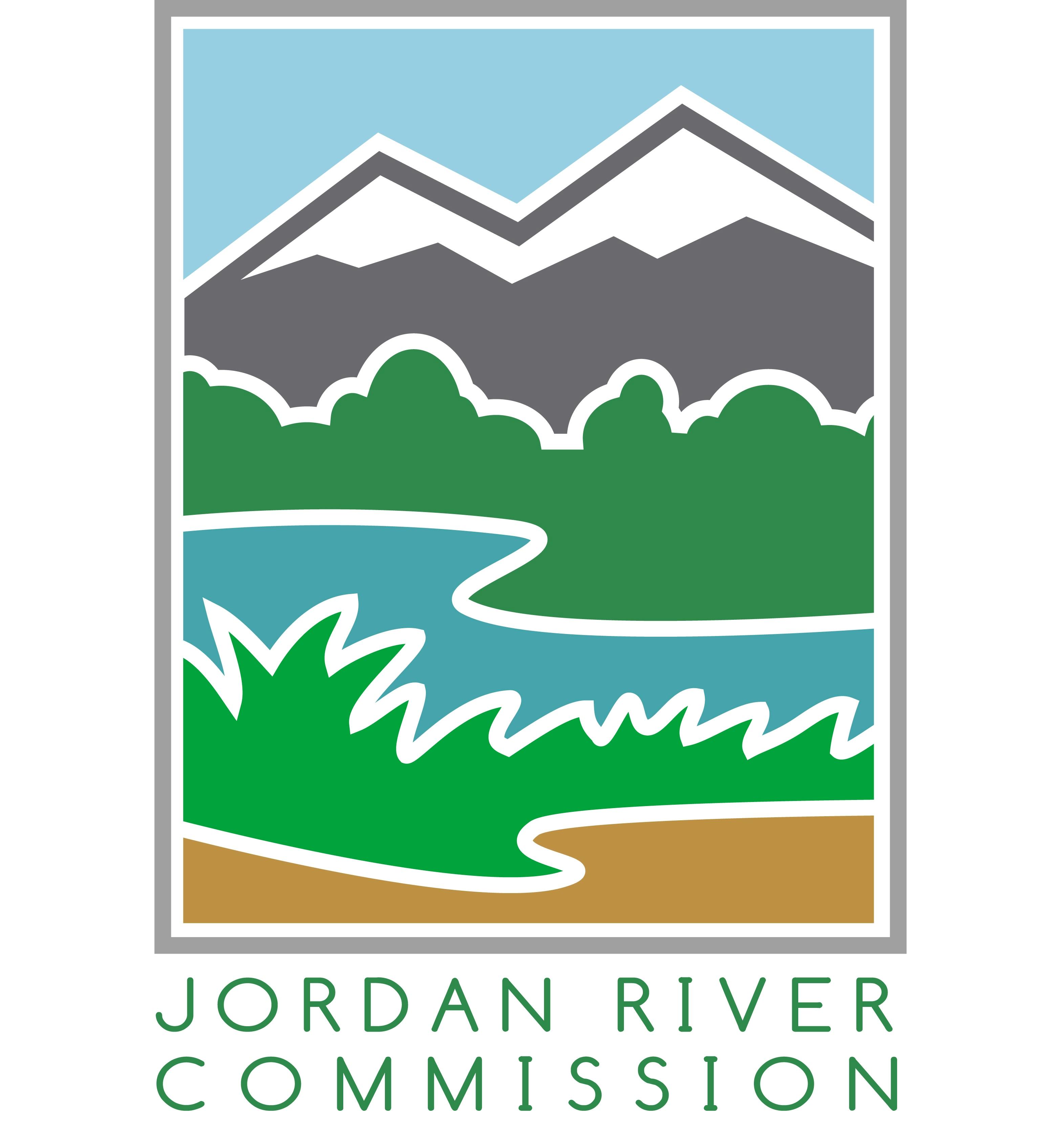Jordan Willow Pond

The Jordan Willow pond is nestled in the community of Jordan Willow. Surrounded by parks, trails, and the Jordan River, the pond adds to the natural landscape of the area. With the climate everchanging the pond water levels can be unpredictable.
ON THIS PAGE:
- Where Does the Jordan Willow Pond Get Water From?
- Water Levels
- Did You Know?
- Groundwater vs Surface Water Flooding
- Resources
- Jordan River Contact
Where Does the Jordan Willow Pond Get Water From?
Groundwater: There is an immense amount of water in aquifers below the earth's surface(External link). Since water flows through cracks and crevices, it can find its way to exposed surfaces to create a body of water such as a pond.
Rain and snowfall: Water runoff from ditch 51 collects drainage water from 2300 West.
Local farmer irrigation: During the summer months, excess irrigation water from local farmers drains from their field to the pond.
 Overflow from pond to ditch 51Water Levels
Overflow from pond to ditch 51Water Levels
The pond gets water from natural sources that are affected by outside elements; therefore the water levels fluctuate throughout the year. Here's examples of elements that affect the water levels:
Causes of Low Water Levels
Drought
Utah has been in drought (External link)eight of the  (External link)last ten years with 99.39% of the state experiencing severe drought, or worse. Dry soils reduce spring runoff effectiveness because the soils soak it up before it can reach reservoirs, streams, rivers, and lakes. During the drought cycle, the groundwater is naturally lower, and the ponds will not receive as much water.
(External link)last ten years with 99.39% of the state experiencing severe drought, or worse. Dry soils reduce spring runoff effectiveness because the soils soak it up before it can reach reservoirs, streams, rivers, and lakes. During the drought cycle, the groundwater is naturally lower, and the ponds will not receive as much water.
Record Heat
The National Weather Service reported the warmest June, July, and August in Utah since the agency started keeping records. August 31st marked the 27th 100° in 2022. High temperatures increase evaporation and reduce water run-off.
Evaporation
Evaporation is caused when the surface of the water is absorbed into the air. High air temperatures, low humidity, strong winds, and sunshine will increase evaporation. The record heat that Utah experienced in the summer of 2022 contributed to the evaporation and low water levels.
Invasive Plants
The Jordan Willow pond area is home to various vegetation. Though these plants create a beautiful landscape around the pond, there are a few that are invasive and choke out the pond. Some of these plants include phragmites and the Russian olive trees. Phragmites consume a lot of water and are known to lower water levels in some wetlands. Its dense stems can also alter the flow of water and clog drainage ditches. The Russian olive tree has been declared a noxious weed in parts of Utah. It is difficult to control and often chokes irrigation ditches.
 Outlet to ditch 51. Beavers will build dams inside the outlet pipe.
Outlet to ditch 51. Beavers will build dams inside the outlet pipe.
Causes of High Water Levels
Beaver
There have been several occurrences of beavers building dams inside the outlet pipe to the Jordan River, which in turn has caused the ponds to fill higher than normal. The beavers have to be removed to keep the area from flooding. Each time a beaver builds a dam, the City removes it and contacts the Division of Wildlife Resources (DWR) to obtain a permit for the removal of the beaver.
Overflow
There are several factors that cause overflow including, rainstorms, snow melt, and beaver dams. Utah experienced above average of monsoon activity in 2022. When the Jordan River is running full, water will surcharge from the river backwards into ditch 51 then into the ponds.
 Jordan Willow Community
Jordan Willow Community (Courtesy of Google Maps)
Did You Know?
- Lehi City does not control the water levels of the Jordan Willow pond.
- Lehi City does not use Utah Lake, or the Jordan River as a water source. The secondary water comes from Deer Creek, Alpine Springs, Provo River, and city wells.
- The Jordan Willow pond area is a wetland. Due to many circumstance such as climate, a wetland might not always be wet.
Groundwater vs Surface Water Flooding
 Homeowners may experience flooding in their basements due to either groundwater or surface water. Groundwater flooding happens when water seeps into the ground and saturates the soil, causing it to rise above the basement floor. This type of flooding typically occurs during the wet season and can be caused by heavy rain, snowmelt, or highwater tables.
Homeowners may experience flooding in their basements due to either groundwater or surface water. Groundwater flooding happens when water seeps into the ground and saturates the soil, causing it to rise above the basement floor. This type of flooding typically occurs during the wet season and can be caused by heavy rain, snowmelt, or highwater tables.
Surface water flooding occurs when water flows across the ground surface and enters the residence through windows, doors, or cracks in the foundation. This type of flooding often occurs during heavy rain or when snowmelt flows downhill towards a home.
Both groundwater and surface water flooding can cause significant damage to basements, but appropriate mitigation strategies may differ. For example, installing a sump pump and French drain system may be effective for addressing groundwater flooding, while sealing basement windows and doors, and grading the surrounding landscape away from the foundation may be more effective for addressing surface water flooding.
GROUNDWATER FLOODING MITIGATION TIPS:
- Install a sump pump: A sump pump can be effective in mitigating groundwater flooding by removing excess water from the basement and redirecting it away from the foundation.
- Maintain proper drainage: Ensure that your gutters, downspouts, and grading direct water away from your foundation to prevent groundwater from pooling around your home.
- Seal foundation cracks: Seal any cracks or gaps in your foundation to prevent groundwater from seeping into your basement through the walls or the floor.
- Waterproof your basement: Consider applying a waterproof sealant to your basement walls and floors to provide an additional layer of protection against groundwater.
- Monitor your water usage: Excessive water usage can increase the water table around your home, potentially leading to groundwater flooding. Monitor your water usage and address any leaks or inefficiencies promptly.
- Consider landscaping: Planting trees and shrubs near your home can help absorb excess groundwater, reducing the risk of flooding. However, be careful not to plant too close to your foundation, as this can increase the risk of water damage.
SURFACE WATER FLOODING MITIGATION TIPS:
- Seal windows and doors: Make sure that all windows and doors in your basement are properly sealed to prevent surface water from entering your home during heavy rainfall or snowmelt.
- Install window well covers: Window well covers can help prevent surface water from entering your basement through basement windows.
- Grade your landscaping: Ensure that the ground around your foundation slopes away from your home to direct surface water away from your basement.
- Maintain your gutters and downspouts: Clean gutters and downspouts regularly to prevent blockages and ensure that water is directed away from your foundation.
- Consider a rain garden: A rain garden can help absorb excess surface water, reducing the risk of flooding around your home.
- Install a French drain: A French drain can be effective in directing surface water away from your foundation and preventing it from entering your basement.
Resources:
Want to know more about the Jordan River?
Utah Division of Forestry, Fire & State Lands(External link)
Jordan River Commission(External link)
Jordan River Contact:
For questions or concerns pertaining to the Jordan River please contact the Jordan River Commission: 801-536-4158 | info@jordanrivercommission.com(External link) | https://jordanrivercommission.com/(External link)
Ask a Question
Have a question? You may submit a question here or call Staff using the contact information above. Questions and answers may be posted to the site.






Thank you for your contribution!
Help us reach out to more people in the community
Share this with family and friends